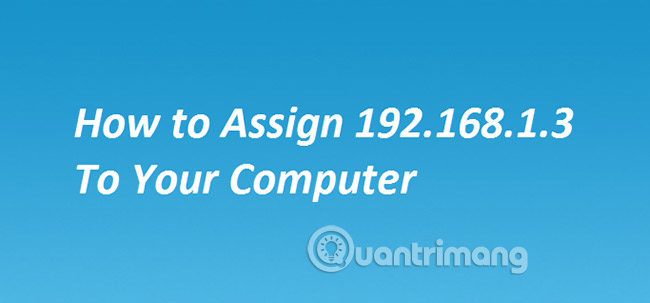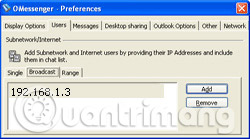Understanding IP address 192.168.1.3
192.168.1.3 is a private IP address, sometimes used on local networks. Home networks, especially those with Linksys broadband routers, often use this address along with other addresses in the range starting at 192.168.1.1.
The router can automatically assign 192.168.1.3 to any device on your local network or an administrator can perform this task.
Automatically assign IP address 192.168.1.3
Computers and other devices that support DHCP can automatically receive their IP addresses from the router. The router determines which address is assigned, from the scope to which it is set up to manage. When the router is set up with the IP address range from 192.168.1.1 to 192.168.1.255, an address for the router itself is needed - usually 192.168.1.1 - and maintains the remaining addresses in a pool. . Typically, the router assigns the addresses in this pool in sequential order, starting at 192.168.1.2, then to 192.168.1.3, etc., although this order is not guaranteed.

Manually assign IP address 192.168.1.3
Computers, game consoles, phones and most other modern network devices allow manually setting IP addresses. The entire address 192.168.1.3 or four digits 192, 168, 1 and 3 must be entered into the network settings configuration screen on the device. However, just entering your IP number does not guarantee the device can use it. The local network router must also be configured to include 192.168.1.3 within its address range.
Problems with IP addresses 192.168.1.3
Most networks specify a private IP address automatically using DHCP. Trying to assign 192.168.1.3 to the device manually, called "fixed" or "static" IP address assignment, can also be done but is not recommended on the home network, due to the risk chance of IP address conflict. Many home network routers have 192.168.1.3 IP addresses in their DHCP pool by default, and the user does not check whether it has been assigned to a client device by manual method, before assigning it to a device automatically. In the worst case, two different devices on the network are assigned the same IP address 192.168.1.3 - a manually assigned device and an automatically assigned device - resulting in a failed connection problem for both devices.

A device with a dynamic IP address 192.168.1.3 is assigned a different address if it is disconnected from the local network for a long enough period of time. This time period (also known as the borrowing time in DHCP) varies depending on the network configuration but is usually two or three days. Even after this time period ends (the DHCP loan period expires), a device is likely to still receive the same address the next time it joins the network, unless other devices also meet. similar situation (also the DHCP loan period expired).
See more:
- Instructions on how to determine the IP address on the computer
- Find out IP Router address 192.168.1.254
- Learn 192.168.0.100 IP address for local network
You should read it
- What is the IP address 192.168.1.5 used for?
- Why is IP address 10.0.0.2 used?
- How to access IP address 192.168.100.1
- Learn 192.168.0.100 IP address for local network
- 192.168.1.2: Common router IP address
- What is a static IP address?
- How to assign a static IP address in Windows 11, 10, 8, 7, XP or Vista
- How does IP address and MAC address work in parallel?
May be interested
- How to Determine the IP Address on a Mac
 when a mac operating system computer connects to a network, it is assigned an address called an ip address (internet protocol address). an ip address has four character ranges separated by spaces, each with a maximum of three characters.
when a mac operating system computer connects to a network, it is assigned an address called an ip address (internet protocol address). an ip address has four character ranges separated by spaces, each with a maximum of three characters. - Things you need to know about Private IP addresses
 private ip address (private ip) is the ip address reserved for internal use via a router or other network address translation (nat) device, completely isolated from external networks.
private ip address (private ip) is the ip address reserved for internal use via a router or other network address translation (nat) device, completely isolated from external networks. - Learn about the mechanism of NAT (Network Address Translation) (Part 1)
 nat allows one (or more) local ip addresses to be mapped to one (or more) external ip addresses. to understand more about nat as well as nat's operation mechanism, refer to the article below.
nat allows one (or more) local ip addresses to be mapped to one (or more) external ip addresses. to understand more about nat as well as nat's operation mechanism, refer to the article below. - 6 ways to view IP addresses on computers, smartphones or Tablet
 when computers or other devices use the same local network, they send information to each other's ip address. if the new ip address is not located in the same network segment as the computer, the device is currently in use, the connection from the computer to the router will be interrupted.
when computers or other devices use the same local network, they send information to each other's ip address. if the new ip address is not located in the same network segment as the computer, the device is currently in use, the connection from the computer to the router will be interrupted. - How to access IP address 192.168.100.1
 192.168.100.1 is a private ip address that can be assigned to any local network device. it can also be assigned as the default ip address for some router models.
192.168.100.1 is a private ip address that can be assigned to any local network device. it can also be assigned as the default ip address for some router models. - 192.168.1.2: Common router IP address
 192.168.1.2 is a private, default ip address for some types of home broadband routing. it is also often assigned to individual devices on a home network when a router has an ip address of 192.168.1.1.
192.168.1.2 is a private, default ip address for some types of home broadband routing. it is also often assigned to individual devices on a home network when a router has an ip address of 192.168.1.1. - Learn 192.168.0.100 IP address for local network
 192.168.0.100 is a private ip address, meaning it is used exclusively on private networks where it will be the ip address of the router or one of the devices on the network.
192.168.0.100 is a private ip address, meaning it is used exclusively on private networks where it will be the ip address of the router or one of the devices on the network. - How to change the IP address for the phone
 there are many reasons users want to change their ip address and there are many types of user ip addresses that can be changed. it is important to find out what kind of address you want to change before continuing.
there are many reasons users want to change their ip address and there are many types of user ip addresses that can be changed. it is important to find out what kind of address you want to change before continuing. - Learn 193.168.0.1: IP address of broadband router
 every device connected to the internet has an ip address or internet protocol address. there are 2 types of public and private ip addresses. the 192.168.0.1 ip address is a private ip address and is the default for some home broadband routers, mainly d-link and netgear models.
every device connected to the internet has an ip address or internet protocol address. there are 2 types of public and private ip addresses. the 192.168.0.1 ip address is a private ip address and is the default for some home broadband routers, mainly d-link and netgear models. - How to Change the IP Address on a Mac
 changing your ip address can be useful if you want to avoid being attacked by other users who are targeting your ip address, or if you simply want a new online identity from an ip standpoint. you can change your ip address on a mac at any...
changing your ip address can be useful if you want to avoid being attacked by other users who are targeting your ip address, or if you simply want a new online identity from an ip standpoint. you can change your ip address on a mac at any...










 Access the home router with admin rights
Access the home router with admin rights How to find the default gateway IP address
How to find the default gateway IP address Understanding IP address 192.168.1.4
Understanding IP address 192.168.1.4 Instructions to scan the network port with Advanced Port Scanner
Instructions to scan the network port with Advanced Port Scanner Learn about WiGig, the new super fast WiFi standard
Learn about WiGig, the new super fast WiFi standard